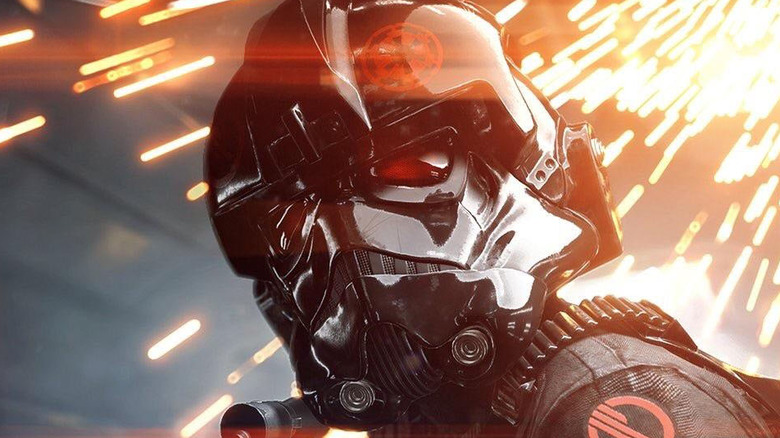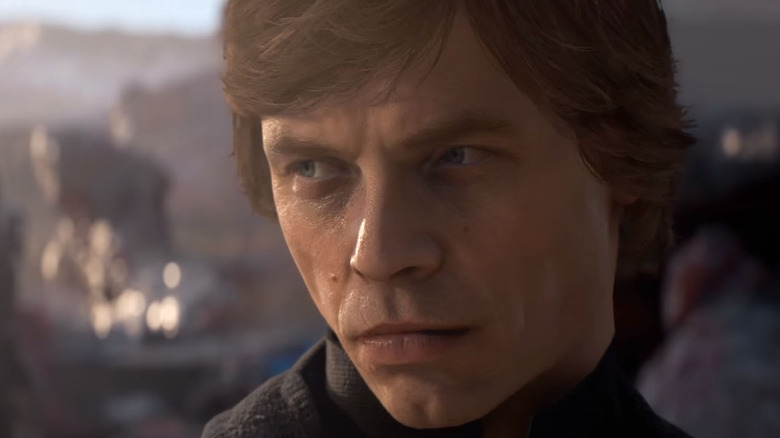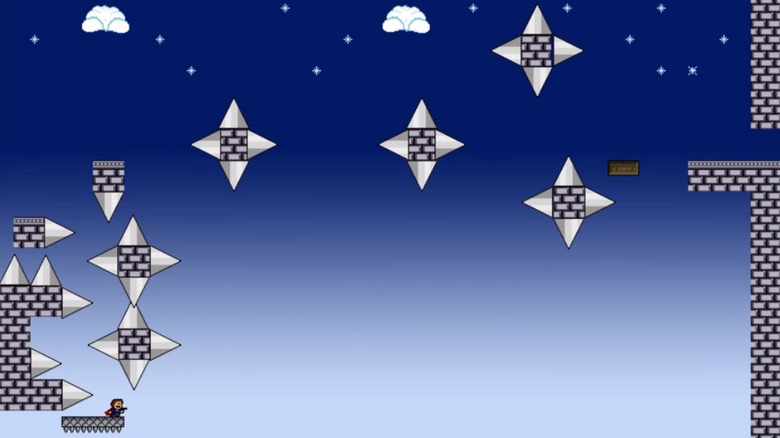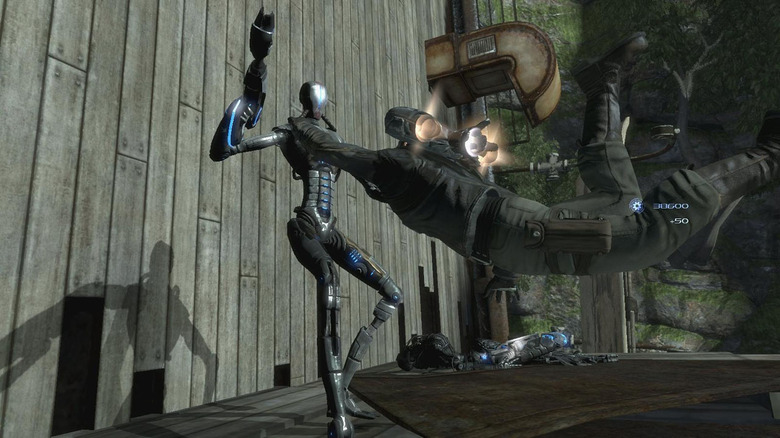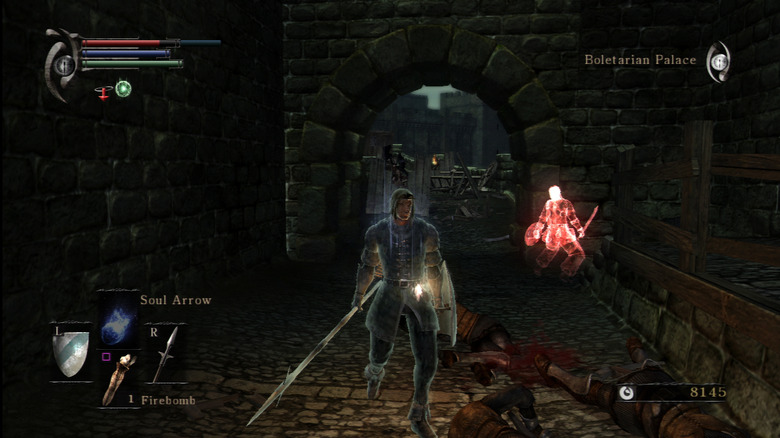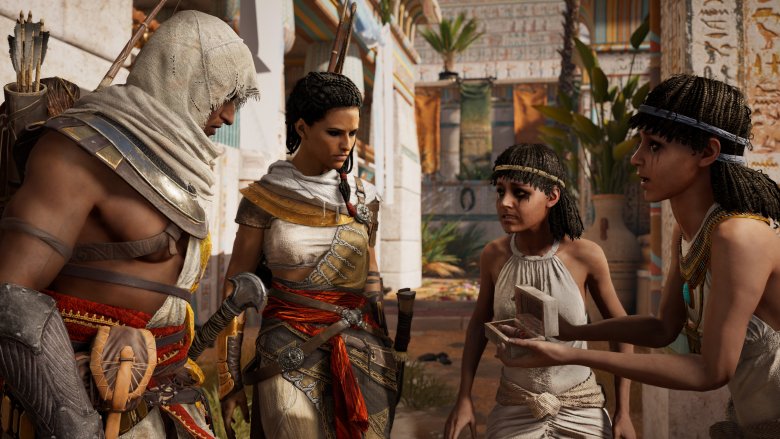Games That Treat The Players Like Trash
Video game companies don't care about you—and they shouldn't. A company's job isn't to make people happy. It's to make money. Ultimately, the big publishers don't answer to you. They answer to shareholders. Many developers and designers are more sympathetic, but it's still a job. They're making games to get paid, not to make you happy.
Sometimes, however, publishers and developers cross the line from indifference to outright disdain. At times, that means milking the audience for some extra dough, even if they've already paid $60 for a full product. Occasionally, a developer releases a game that's actively abusive. Every now and then, designers troll their players for laughs. And so, instead of giving you a good time, the game makes you feel like garbage. No thanks.
EA's Battlefront affront
To Electronic Arts, you're not a galaxy-saving hero or a powerful Sith lord. You're just a wallet with legs. Sure, Star Wars Battlefront 2 delivers on some of its promises—while playing, you will get to visit some of the Star Wars galaxy's most iconic locations, and you'll take part in many of the series' most famous battles. But if you want to step into the shoes of fan-favorite characters like Luke Skywalker, Leia Organa, Darth Vader, or Emperor Palpatine? You're going to have to pay.
Star Wars Battlefront 2's unlock system is inexcusably complicated, but here's the jist: in order to unlock the game's best and most famous heroes, you'll need to buy them using credits. You can earn credits by playing the game, or by plunking down real money to buy crystals, which you can use to buy loot boxes, which may or may not contain more credits, since the contents of each box are semi-random. But here's the catch: during the game's pre-launch preview, Battlefront's two most expensive heroes, Luke and Darth Vader, cost a whopping 60,000 credits each. If you wanted to earn that much money via gameplay alone, one fan estimates that it would've taken 40 hours—and that just gets you one character.
Electronic Arts responded to outraged commenters by claiming that the prices were designed to foster "a sense of pride and accomplishment" when you finally manage to unlock heroes. Fans didn't buy that—EA's response quickly became the least-popular comment ever posted on Reddit—and the company quickly cut its prices by 75%. Don't take that to mean that Battlefront 2 cares about you, your time, or your finances, however. Ten hours is still a lot of time to unlock something that arguably should come with the price of admission, and nothing would've changed if players hadn't picked up their digital torches and pitchforks and formed their own rebel alliance.
Drawn to Death erases your self-esteem
Unless you're a card-carrying masochist, you'll probably want to avoid Drawn to Death, David Jaffe's "edgy" multiplayer shooter. And that's not just because of the game's intentionally garish character designs, the languid match pace, or the immature sense of humor, either. As you play Drawn to Death, the game constantly berates and insults you, slowly chipping away at your self-esteem no matter how well you're playing. Executed well, that could be funny. In Drawn to Death, it's simply exhausting.
The very first screen in Drawn to Death's tutorial calls you an idiot. That's followed up by a sarcastic congratulations message, which you get simply for following the game's instructions. By the end, your guide will have insulted your intelligence, compared you to someone with "fecal intolerance," and said other, worse things that we can't post here.
And that's just the tutorial. The whole game is like that. Yes, David Jaffe—the guy who made Twisted Metal and God of War—always imbues his work with some politically incorrect, macho swagger. But Drawn to Death is so actively hostile that its bad attitude actually led to lower review scores. IGN claims that Drawn to Death's "constant barrage of un-funny abuse" overshadows the game's few positives, and gave it a four out of 10. GameSpot calls it a "non-stop stream of unfunny trolling and insults," and gave it a five. If real life isn't beating you down enough, feel free to give Drawn to Death a try. The rest of us feel bad about ourselves without any extra help, thank you very much.
You probably don't wanna be the guy
Dark Souls is hard, but fair. So is Super Meat Boy, Battletoads, Contra, Sunless Sea, and others. By contrast, I Wanna Be the Guy is hard, but fair it is not. Fast-moving walls of spikes that appear out of nowhere. Killer apples fall (or fly) in all directions. Platforms propel I Wanna Be the Guy's hero right into deadly spikes. In order to cross deadly chasms, you'll need to find invisible platforms that only appear when you land on them. Many paths lead to impassable obstacles and dead ends. And that's just what you'll encounter while navigating the game's first four screens.
If you want to beat I Wanna Be the Guy, you'll need to memorize every pixel of every level. Without lots (and lots and lots) of trial and error and hundreds of deaths, that's not possible. It's not just cruel. It's cruel by design, according to I Wanna Be the Guy designer Michael "Kayin" O'Reilly says. While developing the game, O'Reilly gave an early build to a friend. "He got really angry," O'Reilly told the Escapist, "but in a funny way." O'Reilly started to wonder "'how much can I piss my friend off and have him still play the game?" And development went from there.
Just don't call I Wanna Be the Guy random. As O'Reilly notes in the game's FAQ, predicting exactly what a player is going to do—and then crafting the perfect trap to both surprise and frustrate them—takes a lot of work. Rest assured, when you play I Wanna Be the Guy, you're playing a game that's meticulously crafted to make you as angry as possible. Have fun!
Takeshi's challenge of your patience
Fans of Japanese cinema probably know Beat Takeshi best as the director of Outrage and Hana-bi, or possibly for his role in 2000's Hunger Games-like Battle Royale. But Takeshi's had a long and storied career that stretches all the way back to the '70s, when he and his partner Beat Kiyoshi came together to form one of Japan's most popular comedy acts. In the '80s, Takeshi took a break from acting and comedy to try his hand at video game development. There's just one catch: Takeshi hates video games.
The end result, 1986's Takeshi no Chōsenjō (which loosely translates to Takeshi's Challenge) is a direct assault on video games and anyone stupid enough to play them. Taking the role of a sad-sack businessman, you'll need to engage in all kinds of unpleasant tasks–like drinking, gambling away your money, divorcing your wife–to continue. At one point, you need to sing an irritating karaoke tune three times into the Famicom's microphone. Pass, and you'll face a challenge that involves leaving the controller alone for an hour. Touch a button, and it's right back to the karaoke bar.
There aren't any directions, of course, and if you do manage to finish the game, Beat Takeshi's pixelated face appears, scolding you for taking the game (or any game) seriously. Takeshi's Challenge is more of an art piece than a real game, but that didn't stop publisher Taito from selling about 80,000 copies, mostly to children. That sucks. Making a kid play Takeshi's Challenge isn't technically child abuse, but it's pretty darn close.
Avoid the Dark Void
If you experience motion sickness while playing video games, rest easy: you are not alone. Gaming can be an incredibly immersive experience, and sometimes—especially in first-person games that move quickly—the disconnect between what's happening on screen (motion) and what's happening to your body (in most games, nothing) can confuse your body, making you feel ill.
Most developers try to mitigate motion sickness by adjusting the lighting, camera, and in-game animations to make everything as smooth as possible. Dark Void, on the other hand, simply sells nausea as a feature, not a bug. After all, Dark Void is a shooter about zooming around in a jetpack. That'd probably make you feel a little sick in real life, so why not give players that feeling while they work through the game, too?
"I always say that if we don't make at least one person puke, we've failed," Dark Void producer Morgan Grey says. "We want the vertigo." Grey is absolutely right when he argues that intentionally making players want to throw up makes Dark Void unique. But–surprise!–it doesn't make for a great sales pitch. Judging by Dark Void's mediocre reviews, it seems like most critics agree.
Demon's Souls basically hates you
All of the Souls games are difficult, but only one actively punishes you for failing by making the game even harder. Yes, Dark Souls' hollow form—to which you're reduced if you die while your character is "alive"—carries some disadvantages. In the first Dark Souls, hollow players can't summon others for help. In Dark Souls II, you'll lose five percent of your health every time that you die while you're in a hollow state.
But that's nothing compared what happens after death in Demon's Souls. Not only does it rob you of half of your hit points while you're in soul form, but dying also alters the game's "world tendency," making your surroundings far more dangerous. The more you die while in the living "body" form, the more the world tendency shifts from white to black. In extreme cases, that means losing even more hit points, facing more dangerous versions of some characters, and fending off the fearsome Primeval Demons that appear in predetermined areas.
Black world tendency does have some advantages—enemies drop more souls, Demon's Souls in-game currency, and are more likely to reward you with rare items after they die. If you aren't very good at the game, however, that won't matter. In Demon's Souls, if you die a lot, the game actively punishes you and makes the rest of your journey more difficult. That's a great way to encourage certain players to buckle down and git gud. For others, it's all the motivation you'll need to put your controller down and play something else.
Canine shame in Ninja Gaiden Black
Breaking news: water is wet, the sky is blue, and Ninja Gaiden is very, very difficult. It's been difficult since 1988, when Ninja Gaiden's first home console version hit the Nintendo Entertainment System. In fact, Ninja Gaiden is the game most often used while defining the phrase "Nintendo Hard," which refers to games that are both brutal and well-made, as opposed to games that are challenging because of glitches and poor controls. Its sequels and spin-offs, like the Game Boy-only Ninja Gaiden Shadow, are difficult, too.
Naturally, when Tecmo and Team Ninja decided to reboot Ninja Gaiden in 2004, they made the game hard. Maybe a little too hard. A year later, Ninja Gaiden returned with Ninja Gaiden Black, an updated version of the game that comes with two new difficulty settings: Master Ninja, which is harder than the original, and Ninja Dog, which is much easier. That's helpful for less skilled players, but director Tomonobu Itagaki is pretty clear how he feels about anyone who lowers Ninja Gaiden's difficulty. "Some people who want to beat the game, even if it means being reduced to the level of a dog," Itagaki says, "people who are not afraid to shame themselves to accomplish their goals."
Don't worry, however. If you're not willing to shame yourself, the game will do it for you. After choosing Ninja Dog difficulty (which is only available if you die three times in the first level), your guide, Ayane, strips you of your Master title and expresses her disappointment. You're forced to wear colorful ribbons during the game, and Ayane's portrait replaces yours on the title screen.
Dragon Spirit: The New Legend makes you feel like a shmup
Aside from the fact that you're flying a dragon and not a spaceship, Dragon Spirit: The New Legend looks like a fairly standard shoot 'em up. You take out waves of enemies, including flying squirrels, hydras, and various plants, while dodging incoming projectiles. Naturally, things get very messy very quickly. Like most shmups, Dragon Spirit: The New Legend is pretty hard.
You may not realize exactly how hard, however, if you start the game by playing poorly. Die in the first level, and Dragon Spirit: The New Legend switches to easy mode. Your dragon suddenly changes from blue to gold and is much, much more powerful, and the game is only half as long. While Dragon Spirit's normal plot is a standard sword n' sorcery affair, the "easy" plot reduces your heroic dragon to a small pet, writes off all the danger as a bad dream, and portrays you as a small and frightened child.
The implication is clear: if you play on easy, you're a baby. That's insulting enough, but Dragon Spirit: The New Legend doesn't actually let you know that you're playing on easy. If it's the only way you've played the game, you'd never know that you've only seen half of what Dragon Spirit has to offer. Not only does Dragon Spirit: The New Legend subtly insult casual players in its cutscenes, but it cheats them out of tons of content, too—and if you don't know better, you'd never, ever know it.
Assassin's Greed
For years, Assassin's Creed has disrespected your time. All those icons scattered on Assassin's Creed's expansive maps, marking various activities and collectibles, are just padding. They rarely offer tangible rewards, and prey on both obsessive gamers who want to keep their maps clean, and on dedicated achievement hunters who'll do anything for a couple more points on their gamerscore.
Ubisoft knows this. In fact, the company even vowed to keep map clutter to a minimum in Assassin Creed Origins. The change didn't eliminate filler, however. It just swept everything under the rug. Ubisoft still lets people pay money—real money—to instantly unlock the game's more elusive collectibles. You can earn all of those items by playing, too. But by calling those premium perks "time-savers," Ubisoft's revealing the truth. Grinding for in-game gear isn't fun, it's boring. Your time is more valuable than that, and Ubisoft's figured out exactly how much it's worth.
Still, microtransactions have been part of Assassin's Creed for a while, and though the time-savers stink, they're not new. Charging for map unlocks, on the other hand, is. Previously, Assassin's Creed players could earn maps that revealed the location of hard-to-find collectibles by playing the game. Now, they can only get those maps by using Helix points, which cost money. Even in a world filled with microtransactions, taking a free feature and locking it behind a paywall stings, and it's proof that Ubisoft isn't just coming for your spare time—now, it's after your wallet, too.
PainStation: it's not just a clever name
Losing in a multiplayer game is always unpleasant, but in PainStation it actually hurts. As designed by artists Volker Morawe and Tilman Reiff, the PainStation adds real-life stakes to an enhanced game of Pong by inflicting real-life pain when you fail. When your opponent scores a goal, the machine will give you electric shocks, whip your hand, or raise the heat to an uncomfortable level. Bright flashes temporarily blind players. By invoking bonuses, you can increase pain dished out to your opponent, and you don't win by getting a high score. Rather, the first person to remove their hand from the torture-inflicting "Pain Execution Unit" loses.
Early versions of the PainStation device, which pops up now and then at museums around the world, were especially brutal. Early on, lawyers went after the PainStation for both copyright infringement (understandably, Sony wasn't keen on the pun) and because it inflicted real-life wounds on players, including "bleeding hands" and infections. PainStation developers considered adding torments like pepper spray and "punches in the gut" to later iterations, but decided against it to keep lawyers at bay—and not, y'know, out of actual concern for the players.
If you want to try your hand at the PainStation, it has a permanent home at Computerspielemuseum Berlin, the first museum in the world dedicated to video games and interactive entertainment. There's just one caveat: if you want to play, you need to be 18 or older.
My Summer Car will drive you insane
Spend a virtual summer in 1990s Finland restoring an old car while binge-eating sausages, beer, and sleep. Sounds like a pretty nice vacation, right? Except My Summer Car, which expects you to build a car, including its engine, from scratch, has absolutely no regard for your time or mental well-being. When you fire up the game, you've got a limited supply of rations, over a hundred car parts scattered around your garage, and no instructions on how to proceed.
If you're already familiar with the inner workings of an automobile, you might be fine—provided that you can wrap your mind around the game's tedious and janky controls. Everyone else is totally screwed. Not only do you need to know how a real-life car works to win, but you'll also need to figure out how to drive your utility van, get to the grocery store (oh, you need to find the grocery store, too), take odd jobs to buy auto parts, and make sure that you stay safe. In My Summer Car, if you die, that's it. It's all the way back to the beginning.
To be fair, My Summer Car's official website warns you that the game isn't going to be a laid-back, relaxing experience. "This is not made because this is [a] fun game, but because it is NOT," the site proclaims. The Steam page is similar. "Severe car fever is required to play this properly due to its meticulous approach on car building," the description says. "This game is not for faint [of] heart." Take note. You've been warned.

